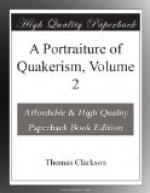[Footnote 164: Mat. 23.18,19,20.]
The first observation, which the Quakers make, is upon the word “THEREFORE.” As all power is given unto me both in Heaven and in earth; and as I can on that account, and as I will qualify you, go ye therefore, that is, having previously received from me the qualification necessary for your task, go ye.
The next observation is, that the commission does not imply that the Apostles were to teach and to baptize as two separate acts, but, as the words intimate, that they were to teach baptizing.
The Quakers say again, that the word “teach” is an improper translation of the original [165]Greek. The Greek word should have been rendered “make disciples or proselytes.” In several editions of our own Bibles, the word “teach” is explained in the margin opposite to it, “make disciples or Christians of all nations,” or in the same manner as the Quakers explain it.
[Footnote 165: [Greek: didasko] is the usual word for teach, but [Greek: word] is used in the commission; which latter word occurs but seldom in the New Testament, and always signifies to “disciple.”]
On the word “baptize,” they observe, that because its first meaning is to wash all over, and because baptism with Christians is always with water, people cannot easily separate the image of water from the word, when it is read or pronounced. But if this image is never to be separated from it, how will persons understand the words of St. Paul, “for by one spirit are we all baptized into one body?” Or those of Jesus, “Can ye drink of the cup that I drink of, or be baptized with the baptism that I am baptized with?” Or, if this image is not to be separated from it, how will they understand the Evangelists, who represent Jesus Christ as about to baptize, or wash all over, with fire? To baptize, in short, signifies to dip under water, but, in its more general meaning, to purify. Fire and water have equally power in this respect, but on different objects. Water purifies surfaces. Fire purifies by actual and total separation, bringing those bodies into one mass which are homogeneous, or which have strong affinities to each other, and leaving the dross and incombustible parts by themselves.
The word “in” they also look upon as improperly translated. This word should have been rendered [166] “into.” If the word “in” were the right translation, the words “in the name of the Father, and of the Son, and of the Holy Ghost,” might be construed into a form of words to be used at the time of baptism.
[Footnote 166: The word in the original Greek is [Greek word] and not [Greek word]]
But we have no evidence that such a formula was ever used, when any of the Apostles baptized. Indeed, the plain meaning of the word is “into,” and therefore all such formula is groundless.[167] “Jesus Christ did not, says Zuinglius, by these words institute a form of baptism, which we should use, as divines have falsely taught.”




